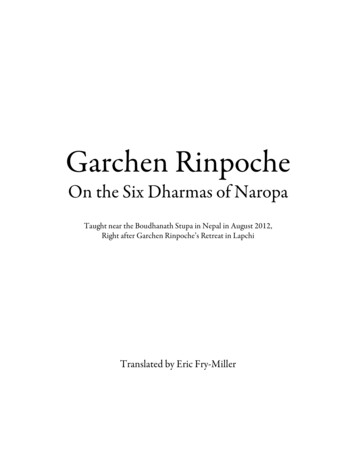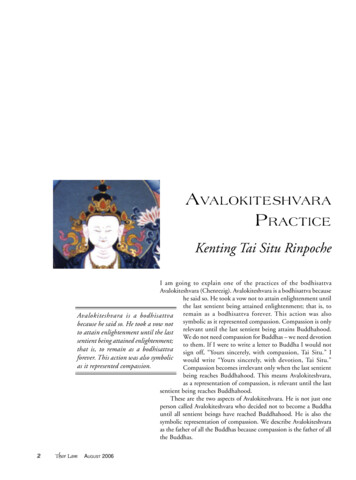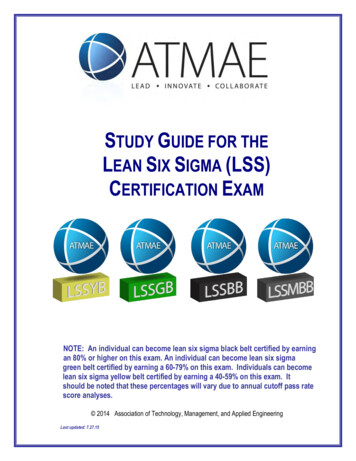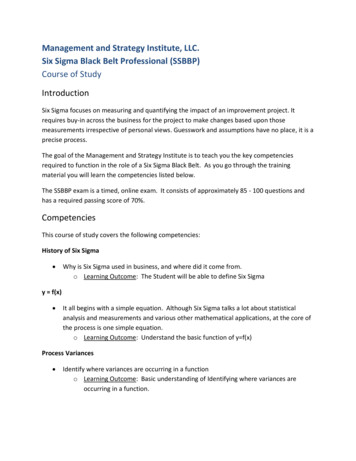
Transcription
Garchen RinpocheOn the Six Dharmas of NaropaTaught near the Boudhanath Stupa in Nepal in August 2012,Right after Garchen Rinpoche’s Retreat in LapchiTranslated by Eric Fry-Miller
BackgroundIn terms of formal Six Dharmas of Naropa practice, I have merely practiced abbreviated versionsof Jigten Sumgön tummo instructions. Traditionally, one practices Five-fold Mahamudraincluding Chakrasamvara, then Vajrayogini, and then the Six Dharmas of Naropa. One and ahalf years into my planned three year retreat, the Chinese armies invaded and interrupted mypractices. Thus, I have mainly practiced the concise instructions contained in Jigten Sumgön’sProfound Dharma, focusing just on the navel. The main Lama I received transmissions fromconcerning the Six Dharmas of Naropa is Chime Dorje, though I did not receive extensiveinstructions. Generally, unless one has received extensive instructions on Vajrayogini, one doesnot proceed to the Six Dharmas of Naropa. After finishing Five-fold Mahamudra, one beginsVajravarahi practice. One did not even look at the teachings of the Six Dharmas before this.They were hidden deeply. These days everyone can look at everything. There are texts printedeverywhere. Back in the day, however, you were not allowed to see those texts. Without doingVajravarahi, you were not allowed to practice the Six Dharmas.Chime Dorje, who passed away in 1959, was a student of the masters of Katsel Monastery, whopracticed the Six Dharmas of Naropa for thirteen years in retreat. He was a real siddha. Hecould actually place his feet in solid stone. You can see this just like you can see Milarepa’sfootprints. We have some of these footprints around Gargön Monastery. Even his horse wasable to leave footprints in rock. He practiced in retreat for thirteen years under the guidance ofthe previous Garchen Rinpoche, Trinley Yonkyab. He would never wear animal skins or fur.All the other Tibetans were wearing leather and fur, but he would never wear anything butcotton, summer, winter, spring, or fall. He also never ate any meat at all, whatsoever. He onlytaught a few people the Six Dharmas of Naropa, mostly just retreatants. He would tell mostpeople to recite the Mani mantra, meditate on cause and effect, and cultivate bodhichitta. Hewould give them teachings on the Thirty-Seven Practices of the Bodhisattvas. He wouldn’t justteach the Six Dharmas of Naropa everywhere.I received some instructions in the Profound Dharma tradition of Jigten Sumgön aboutmeditating upon fire at the region of the navel. There are some special instructions in JigtenSumgön’s tradition called the Three Dharmas, the Ten Dharmas, the Three Instructions, and soforth. I also received some special instruction on working with the subtle essences from myfather. My first real teacher of the subtle channels and energies was my father. Then, I receivedteachings that were very beneficial from Chime Dorje. These teachings explained the vastqualities of tummo fire. When I received the Vajravarahi empowerment, we had to swallow fire.This was the secret tummo empowerment. When it came to me to swallow fire, I was extremelyfrightened. What would happen if I ate fire? They only do this in rare circumstances these days,just a little candle flame. You take it in your mouth. This is called the fire empowerment oftummo.2
My father, who passed in 1963, taught me some instructions on tummo. At the level four fingerwidths below the navel, one was to unite the subtle energies, mind, and subtle essences togetheras one. It is key to combine them with the mind. If you just do the vase breath, but you do notunite the mind with the breath, you do not know what you are doing. To unite the mind withthe subtle essences of the body, the breath is a friend. If you control your breath, you willcontrol the subtle essences. You will realize that the mind is in control. For instance, if youmeditate upon a white Hum syllable. Wherever you visualize the white Hum, the mind follows.Thus, you can control your energies.My father practiced in the Barom Kagyü tradition. He spent many years in retreat. He wasalways in retreat. He had another wife. My mother just kind of happened into his life. He laterbecame my teacher. His Lama was Barwai Dorje. The first Barwai Dorje was also the Lama ofthe previous Garchen Rinpoche, Trinley Yongkyab. They had a very deep connection.Thus, in this life, I have only formally been in retreat for one and a half years years, but whereverI go, my mind is in meditation. For instance, there was a period where I did not sleep at alllaying down for ten years. I went without sleeping normally for ten years straight. During theday, I went all kinds of places and did things, but at night I would meditate uninterruptedly.How much time do we waste sleeping every night? All I wore was a thin skirt, and I sat up withmy meditation belt. Later, my doctor told me that I had to sleep laying down for at least fivehours every night so that blood would circulate properly.In terms of teaching the Six Dharmas, I have given reading transmissions. To all my students inretreat, I also give tummo meditation instruction. There are differences in the faith of mystudents from different areas, but their capacities are the same. Some people from somecountries have more experience with different traditions. Those who have trained in pranayamain the past, for instance, find it easy to understand teachings on tummo. Those who have donepractices like Zen, for example, can understand calm abiding more easily.The most important thing for students to have is bodhichitta. To really cultivateenlightenment, you have to have a lot of bodhichitta. To gain vast wisdom, you have to havebodhichitta. If you just try to cultivate wisdom without a lot of love, it doesn’t work. That typeof wisdom does not become deep and profound. On the other hand when you cultivate love,compassion, and bodhichitta, then wisdom becomes extremely deep and profound.3
Tummo Fire MeditationThe essence of tummo fire is heat. The essence of heat is bliss. The essence of bliss is the essenceof mind. Milarepa taught:Inside the womb of the mother, emptiness dwells.Inside emptiness, bliss dwells.Inside bliss, clarity dwells.So first there is bliss. Inside bliss you find emptiness. When you realize the emptiness inside ofbliss. There is clarity. This clarity or inner illumination is non-conceptual. In this sense, there isbliss, clarity, and non-conceptuality.When we normally have bliss, we do not recognize the essence of that bliss. Ordinary peoplethink that bliss only comes from others. For us yogins, we have bliss through relying on skillfulmethods. When we halt the stream of conceptual thoughts in our minds, there is natural bliss.For example, when wind blows clouds from the sky. You can see the open sky. For true bliss,you have to stop the stream of conceptual thoughts about desire. When thoughts cease, thenature of the mind itself is bliss.Ordinary people think that bliss comes from someone else. For instance a girl might think thatbliss comes from a boy. A boy might think that bliss comes from a girl. Thinking like that, allkinds of things like attachments and jealousies arise. When we practice and let go of conceptualattachments, we realize that the mind itself, freed from concepts, is bliss. It is the same bliss thatwe think comes from outside of ourselves. When we realize this, we realize great bliss, the greatbliss of the body of reality, the dharmakaya. The ultimate body all reality arises as great bliss,when it is free from concepts.It says in Chakrasamvara instructions that through the experience of conditioned ordinarybliss, we can come to realize unconditioned non-conceptual bliss. This great bliss is not limitedto the conditioned body. Whenever we meditate upon the nature of the mind, we canexperience this unconditioned bliss. When you reach this point, you have control and freedomover happiness. At this point you need no one else.First to train, however, you can bring about the experience of great bliss in your body, while youare in union with someone else. Then, in your mind you can recognize, “Oh, this is whatpowerful conditioned bliss feels like.” When you look at the essence of that, you see that suchbliss arises simultaneously with emptiness. Thus, it becomes an introduction to the experienceof unconditioned non-conceptual bliss. This is what the practice of sexual union is all about.4
The essence of tummo meditation is focusing on fiery heat. One doesn’t just meditate on this inan ordinary way. This body of ours came from our mother and father. When we were growingin our mother’s womb, her energy and life-force entered us through our navels, making it a veryspecial place. It is said that through the white essence we received from our fathers, we gave riseto the afflictive emotion of aversion and this generated our bones. Through the red essence wereceived from our mothers, we gave rise to desire and this generated our blood and flesh. Whenwe meditate on a fire inside our body, it allows the subtle winds of the body and mind to gatherthere. When we unite the energy of fire from our minds with the breath of the body, theybecome friends very quickly. This causes heat to quickly grow. For instance, if you have a littlefire and you blow upon it, it blazes up. In this way, through meditating on fire united with thebreath, you can generate heat very quickly and you don’t need to get warmed up by any outersource. Heat comes from within.The place of meditation is at the navel. This place is the sacred place in our body where wereceived the energy of our mothers. This is why we meditate on Vajravarahi at the place of thenavel. In Milarepa’s Guru Yoga we meditate on her in the form of the seed syllable Hri,surrounded by the syllables of the four dakini mothers, Ha, Ri, Ni, Sa. In the context of tummopractice, we meditate on Vajravarahi in the form of a blazing A stroke at or below the navel.The blessing of our mother truly abides in our precious human bodies You can see the sign ofthat blessing in the form of your navel. When we hold our breath there, using the method of thevase breath, the breath unites with our mind at this place in our body. Heat is ignited. This isthe essence of the meditation of tummo.Heat is generated in the body. Heat is necessary to live. It is part of our life-force. When heatwanes, our life wanes. Longevity is heat. It is fire. Our life-force is really heat. When ourconsciousness separates from the heat in our bodies, we die. Death in the body occurs when welose this heat of our life-force. So, one benefit of mixing consciousness with heat in the body islongevity. Also, when you have heat, there is bliss. When you have bliss, there is clarity. Whenyou have clarity, there is non-conceptual realization.If ordinary practitioners just think about heat, but do not use it to recognize bliss, clarity, andnon-conceptuality, all they will get is just a little heat. One of the accomplishments of tummopractice is heat. This is not just a Buddhist thing. In other spiritual traditions that work withthe breath and pranayama, they have such accomplishments. They can also accomplish all sortsof magical powers like being able to fly through the air and such. These are accomplishmentsthat you can likewise gain through tummo practice.For us, in the vajrayana Buddhist tradition, we seek the supreme accomplishment. Thus, firstwe give rise to heat. This allows the mind abide steadily at that point in the body. Thus, thesubtle bindus or sexual energies increase. From this, bliss is generated. Then, one looks into theessence of that bliss. One sees that the essence of that is emptiness. Looking into the essence ofemptiness, one sees the clarity or luminosity of the mind. That clarity or luminosity is theinnate awareness of the nature of the mind. This luminosity is self-knowing self-awareness. It isalso called the primordial wisdom of self-awareness.5
This is not just a mere conceptual clarity or luminosity in the mind. Sometimes we have thefeeling that our minds are clear or bright. That is not just what is going on here. Here we aretalking about a clarity or luminosity of knowing the nature of the mind itself. If we do notrecognize the innate energy of self-knowing awareness, we will not understand that it is nondual. The goal is non-dual primordial wisdom. We think of things as self and other, male andfemale. Yet, ultimately the empty nature of the mind has a luminosity to it. That luminosity isnon-dual self-awareness. In realizing non-dual primordial wisdom, we travel beyond concepts ofself and other. When you investigate the essence of awareness, you find that it is like the natureof space. Milarepa said:There is no difference between space and mind in the ultimate body of reality.When you realize that the mind is like space and you open your eyes, you see that all reality isopen like space. Concepts of a body of flesh and blood, pop like a bubble. What we think we areis really just our minds. We think, “You have your mind and I have my mind." However, wedon’t see that the nature of our minds is the same. When we realize that our own minds are likespace and we also realize that the minds of others are like space, there is no duality between us.Space does not have duality.We can divide space, for example, between the space outside and the space inside a vase, butspace cannot be ultimately separated. When you realize this, you can understand non-dualprimordial wisdom. When we are caught up in discursive thoughts, we cannot see this. Whenwe abide in non-dual primordial wisdom, all our afflictive emotions and discursive thoughtsbecome inseparable from primordial wisdom itself. Everything becomes primordial wisdom.When all becomes primordial wisdom, even if we have a strong emotion of anger for instance,we see that it exists in the space-like nature of the mind. Recognizing the essence of the afflictiveemotion of anger to
The essence of tummo meditation is focusing on fiery heat. One doesn’t just meditate on this in an ordinary way. This body of ours came from our mother and father. When we were growing in our mother’s womb, her energy and life-force entered us through our navels, making it a very special place. It is said that through the white essence we received from our fathers, we gave rise










